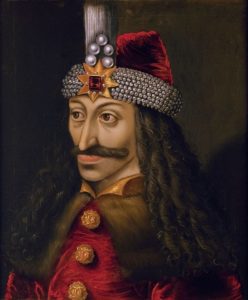Most of us are quite familiar with Bram Stoker’s famous novel, Dracula – the story of the horrific Count and vampire. But did you know he was inspired by a real life ruler? Welcome to this article about the inspiration behind Count Dracula; the 15th century Prince of Wallachia (a region in present day Romania), Vlad III, who was more commonly known as Vlad the Impaler.

Interesting Facts about Vlad the Impaler
1. Vlad was born in Transylvania.
Vlad was born between 1428 and 1431 (the exact birth date is unknown) and he was the second son of Vlad II Dracul. Records of his mother are not clarified and it is thought that she may have been the Princess Cneajna of Moldavia. Vlad was born in the town of Sighisoara, Transylvania. His brothers included Vlad Calugarul, Mircea II and Radu III.
2. His brother and he were captives of the Ottomans.
Vlad II, along with Vlad and Radu, traveled to the Ottoman city of Gallipoli upon request of the Sultan Murad II. However, much to their surprise, they were imprisoned by the Sultan. Vlad II came to an agreement with the Sultan and allowed Vlad and Radu to remain captives while he was set free, as means of securing loyalties with the Ottoman Empire.
3. He ruled Wallachia in 3 separate periods.
After his father and elder brother passed away, Vlad became the heir to the throne of Wallachia. However, during his first rule, Vlad waged war against the Ottoman empire in 1448, with the help of John Hunyadi. Unfortunately for Vlad, the war was lost and he had to flee. He lived in exile for a period of 7-8 years before returning. Upon reclaiming the throne for the second time, Vlad declared himself as the Voivode of Wallachia in 1456. This was the period during which he became well known for the most brutal acts.
4. Vlad had vicious methods of executing enemies.
He began to take action towards Romanian Independence and implemented the use of biological warfare. This was carried out by sending infected individuals who carried contagious diseases to the Ottoman armies. The majority of the Turks died but the remaining were impaled on spikes outside the walls of the city. When the Ottomans invaded Wallachia after this, their leader, Sultan Mehmed II apparently fled at the sight of seeing the 20,000 corpses that were impaled on the outskirts of Targoviste. Vlad had intentionally left this in order to deter the Turkish forces from invading the city.
5. He focused on doing the best for his kingdom.
Despite these atrocious acts, Vlad had a pretty accomplished career as the Prince. He focused on enhancing the economy of the region by reforming the agricultural systems and strengthened his military. He also constructed several buildings and villages for the general population and encouraged foreign trade. Added to this, he maintained the discipline and low crime levels of the region by ruthlessly punishing any criminals, as well as those who would betray Wallachia.
6. He was also known as Vlad Dracula.
History has also revealed that an alternative name for Vlad was Vlad Dracula. This was derived from his father’s original name, Vlad II Dracul. Dracul was originally thought to translate to the word ‘dragon’ but it is debated if this was the actual translation or if it actually meant ‘devil’. Vlad II apparently joined the Christian Order of the Dragon which opposed the Ottoman rule and later, ‘dracul’ came to be incorporated into his name. Eventually, ‘Dracula’ would serve as the inspiration behind Bram Stoker’s fictional monster as well.
7. He died in battle during his third reign.
In 1462, Vlad was captured by Matthias I of Hungary. But he managed to reclaim his throne in 1476. However, his third rule was only short as it seemed; he was killed the same year after going into battle near Bucharest. The Ottoman army severed his head and took it to Constantinople. The exact location of his burial site is unknown, although it is said to be in a monastery in the south of Wallachia.
8. The legacy of Vlad the Impaler is one to be questioned.
Collectively, we can agree that Vlad the Impaler had a distinct legacy. He is revered and respected in Romania for defending his kingdom from the Ottomans. However, he is considered as a monstrous leader in other areas of Europe for the tyrannical acts he committed. It is clear that most rulers did execute their criminals or prisoners, but Vlad the Impaler’s methods of execution were far more brutal and inhumane. It is rumoured that he took great pleasure in the excruciating killing of his enemies. Therefore, it comes as no surprise that this heinous reign serves as inspiration for one of the most famous vampires of all time, Bram Stoker’s Count Dracula.
I hope that you liked reading these facts about Vlad the Impaler. If you want to know more about other historical figures, visit the historical people page.
